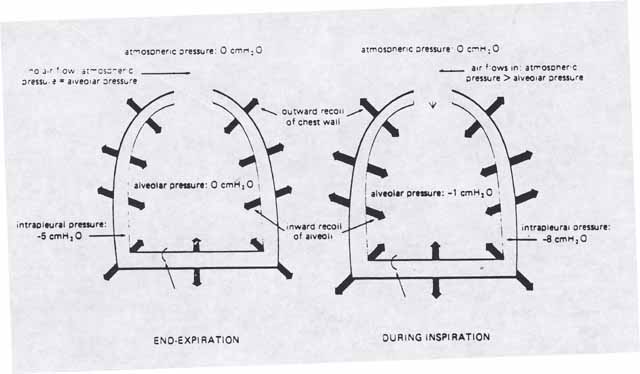
| MadSci Network: Anatomy |
Well, so many questions would actually require a one-to-one sitting with lots of figures, books around us and explanations. But I'll try my best to put it short. At the end, I've mentioned a few websites from where I got my information and photographs.
So, the first question. Well, lungs are comprised of mostly alveoli; they're called the basic units of the lungs. Surrounding the alveoli, we have blood vessels (for exchange of gas), and elastic tissue - which help in breathing. Take a look at the sketch below

And also this picture of the lung in cross section

The presence of elasic tissue in the lung helps a lot in respiration. Initially, alveolar pressure equals atmospheric pressure so that no flow occurs. Contraction of the inspiratory muscles [the muscles of inspiration include the diaphragm, the external intercostal muscles and the accessory muscles] enlarges the thorax, lowering intrapleural pressure, which causes the alveoli to distend.
As the alveoli distend, the pressure within them drops and air flows into the alveoli. As the air flows in, pressure returns to atmospheric and airflow ceases. The lung volume is now increased and the inspiration has ended. The respiratory muscles relax and the intrapleural pressure becomes less subatmospheric. The elastic recoil of the alveolar walls compresses the alveolar gas, raising alveolar pressure above atmospheric, and gas flows out of the lung.

The lung and chest wall can be modeled as springs or elastic bands which get stretched during inspiration and recoil when the muscles relax during expiration.
The elastic recoil of the lung reflects two major components
Tissue elasticity - the lung tissue contains elastin, collagen and other components which stretch and recoil when released.
Surface tension - surface forces exist at any gas liquid interface such as we have in the alveolus.
These lines have been picked up from the following website
http://physioweb.med.uvm.edu/pulmonary_physiology/
This site explains in an excellent way how breathing occurs, with good
figures. The previous figure is from this same site.
The other figures were picked up by browsing various links on www.medicalstudent.com.
Hope this helps you
Try the links in the MadSci Library for more information on Anatomy.